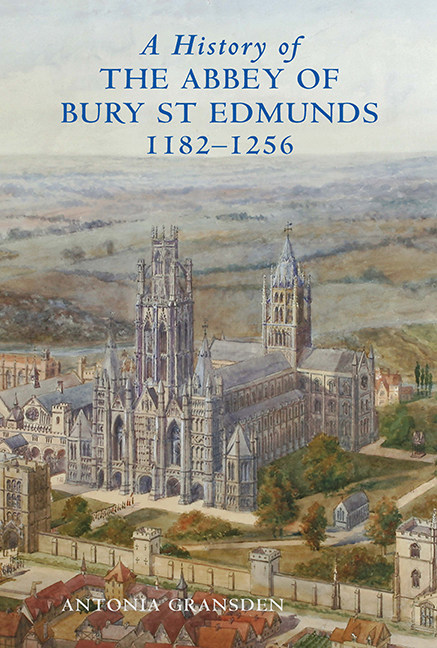Book contents
- Frontmatter
- Dedication
- Contents
- List of plates
- List of figures
- Preface
- Editorial Note
- Epigraph
- Acknowledgements
- Maps and plans (figures 1–9)
- Part I Samson of Tottington, Abbot 1182–1211
- 1 Samson's biographer, Jocelin of Brackland (de Brakelond), and his work
- 2 Samson's early life and career
- 3 Samson's election to the abbacy
- 4 The early years of Samson's abbacy and reform of estate management
- 5 Conflict with the convent
- 6 Relations with the town of Bury St Edmunds
- 7 Samson and secular law
- 8 Samson and the knights of St Edmund
- 9 Relations with the Angevin kings
- 10 Samson and the papacy
- 11 Samson as a builder
- 12 Religious and intellectual life under Samson
- 13 Samson's death and burial
- PART II The Abbey 1212–1256
- APPENDICES
2 - Samson's early life and career
from Part I - Samson of Tottington, Abbot 1182–1211
Published online by Cambridge University Press: 29 April 2017
- Frontmatter
- Dedication
- Contents
- List of plates
- List of figures
- Preface
- Editorial Note
- Epigraph
- Acknowledgements
- Maps and plans (figures 1–9)
- Part I Samson of Tottington, Abbot 1182–1211
- 1 Samson's biographer, Jocelin of Brackland (de Brakelond), and his work
- 2 Samson's early life and career
- 3 Samson's election to the abbacy
- 4 The early years of Samson's abbacy and reform of estate management
- 5 Conflict with the convent
- 6 Relations with the town of Bury St Edmunds
- 7 Samson and secular law
- 8 Samson and the knights of St Edmund
- 9 Relations with the Angevin kings
- 10 Samson and the papacy
- 11 Samson as a builder
- 12 Religious and intellectual life under Samson
- 13 Samson's death and burial
- PART II The Abbey 1212–1256
- APPENDICES
Summary
Samson was born in 1135 at Tottington in Norfolk (about nine miles northeast of Thetford). One night he dreamt that he was standing before the gates of the cemetery of St Edmund's abbey and the devil tried to seize him, but he was saved by St Edmund himself who held him in his arms. Therefore, Samson's mother took him to visit St Edmund's shrine. He was nine years old at the time. It would seem that Samson's regard for St Edmund and the abbey originated with this episode. His early education was as a poor clerk in the school of Master William of Diss who admitted him free of charge (‘sine pacto et caritative’) and whose son, Master Walter of Diss, was a monk of St Edmunds. Samson then studied, again as a poor clerk, at Paris university. He apparently graduated, becoming a ‘Master of Arts and Medicine’. At some stage he was ‘a well known and respected’ schoolmaster apparently in Norfolk.
Samson was probably a clerk in the service of the abbot and monks of St Edmunds when c. 1159–60 he was employed by the monks on an important mission. They sent him to Rome with a letter appealing to Alexander III to restore a pension of 10 marks owed to them from the revenues of the church of Woolpit. The church belonged to the abbot and the pension had lapsed, very likely because pressure from the king had caused the church to be given in free alms to a royal clerk. But c. 1159–60 the church fell vacant and the monks saw their chance of recovering the pension. Jocelin describes Samson's journey in dramatic detail. Unfortunately for the mission, there was a schism in the papacy. On the day of Alexander III's election by the majority of cardinals (7 September 1159), supporters of the emperor Frederick Barbarossa had elected Cardinal Octavian as Victor IV. Samson heard that Victor's supporters were liable to capture and mutilate those bearing letters to Alexander. Apparently he (wrongly) believed that the Scots supported Victor and, therefore, he disguised himself for the journey as a Scot.
- Type
- Chapter
- Information
- A History of the Abbey of Bury St Edmunds, 1182–1256Samson of Tottington to Edmund of Walpole, pp. 12 - 16Publisher: Boydell & BrewerPrint publication year: 2007



